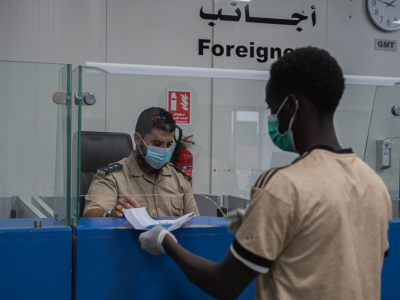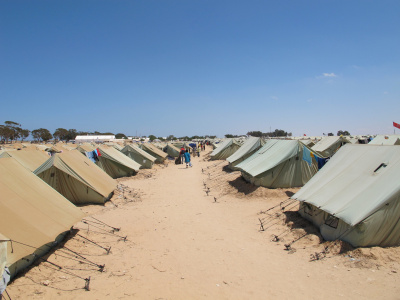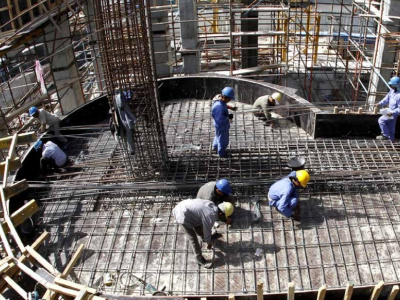
Spirited away: The fading importance of resettlement in the emergency transit mechanism in Rwanda
On 10 October, 123 refugees were evacuated from Libya to Rwanda. This is the second evacuation under the new emergency transit mechanism (ETM) set up in September by the government of Rwanda, the UN Refugee Agency (UNHCR) and the African Union (AU), and funded by the AU and the European Union (EU). The ETMs – a humanitarian scheme – threaten to be co-opted by politics as they are changing in their very nature, with resettlement increasingly off the table.
According to the Rwanda agreement, a total of 500 refugees and asylum seekers held in detention will be transferred voluntarily to Rwanda. There, long-term solutions for evacuees include resettlement, but also voluntary return to countries where they had previously been granted asylum, return home if safe and voluntary, or integration into local Rwandan host communities. While ETMs have existed in the past, making resettlement only one of several options constitutes a striking difference to prior schemes.
The 2011 UNHCR guidance note on emergency transit facilities, referring also to ETMs, highlights that such schemes are set up to enable resettlement processing of refugees who otherwise cannot access these due to immediate risks. UNHCR warns that to avoid refugees becoming stranded after evacuation, evacuations must be ‘pre-conditional upon a resettlement country agreeing to undertake further resettlement processing’.
The shift away from the resettlement focus under the newly established ETM with Rwanda could have two reasons. It might stem from lessons learnt from the rocky implementation of the emergency transit mechanism in Niger, which became operational in the last quarter of 2017, or it could be linked to political calculations of the European funding partner.
Lessons from the emergency transit mechanism in Niger
Compliance with the initial UNHCR-Niger agreement, which lays down the conditions under which evacuations to Niger may occur, has proven impossible. According to the initial agreement, a maximum of 600 evacuees are permitted to reside on Nigerien territory at the same time, although exceptions can be made in humanitarian emergency situations when extraordinary measures are authorised.
Further, evacuees may only reside in Niger for a maximum period of six months, to be solely extended in exceptional circumstances and on an individual basis. Finally, although the Nigerien government does not oppose the principle of granting asylum to evacuees who do not match resettlement requirements of third states, they can only receive the right of residence for transit purposes.
As of 22 October 2019, a total of 2,913 persons have been evacuated to Niger from Libya, of whom 1,024 have remained in the country. Observers note that some refugees arriving in the first evacuations are still present in Niger.
Tensions arising from non-implementation of the initial agreement have been met with curtailing transparency and no official communication regarding its potential extension beyond 2019. Discontent over the slow resettlement pace even led to the temporary halt of the scheme in 2018.
Findings of our fieldwork in Niger, during which we conducted more than 40 expert interviews in the framework of our project ‘The political economy of migration politics in West Africa’, clearly indicate tensions over the future of evacuees whose stay in Niger might not be of temporary nature. Moreover, the arrival of additional self-evacuated refugees has not been well-received.
First, the large number of evacuees awaiting resettlement (or alternative solutions) resulted in a changed approach to refugee housing throughout the ETM. Earlier this year, UNHCR opened a camp – or ‘transit centre’ – in Hamdallaye, 40 km outside of the capital Niamey, where evacuees were previously hosted in residential homes.
This move reduces the ability for income generation and refugees have protested against the dire conditions in the new transit centres. This is far from a sustainable crisis solution and shows the beginning of a protracted crisis, paired with an out-of-sight-out-of-mind approach to problem solving.
Second, in early 2018 about 2,000 asylum seekers arrived in Agadez – most of whom were Sudanese and self-evacuating from Libya. They sought relative security, but were also influenced by misinformation stating an asylum application in Niger would quickly lead to resettlement in Europe.
Political and social hostility towards the newcomers cumulated in the refoulement of 135 Sudanese asylum seekers back to Libya in May 2018. Today, ‘self-evacuees’ are among those hosted in a camp outside Agadez. Lengthy procedures and dire conditions in this desert camp resulted in some people leaving, even though this meant returning to Libya.
The tensions over implementation of the emergency transit mechanism in Niger might be the reason why first, resettlement is officially not the priority solution for evacuees anymore, and second, far-away Rwanda is an attractive partner for the scheme – decreasing the likelihood of the arrivals of self-evacuees.
A humanitarian solution to a political problem?
The political context in which the scheme was agreed on suggests that different political calculations are at play. In view of the absence of political will to solve the humanitarian crisis that refugees and migrants face in Libya, the shifting resettlement focus in the scheme allows European actors to keep arrivals of refugees to a minimum while maintaining their humanitarian face. Meanwhile, for Rwanda, cooperation on migration might be used as a bargaining chip.
Rwanda is not new to gain politically from hosting refugees. The country has previously accepted ‘voluntary’ returns from Israel of primarily Eritrean and Sudanese refugees (who faced the alternative of imprisonment, repeatedly challenged through the Israeli courts).
While Rwanda (much like Uganda) has denied any deals with Israel, including payments for each refugee, weapons, military training and development aid, rumours persist. After widespread protest however, the Rwandan government has retreated from the policy, although an Israeli embassy was opened earlier this year.
While Rwanda is keen to portray the humanitarian motivations behind the evacuation schemes, refugees have also faced challenges in the country. After protests broke out in the Kiziba refugee camp last year following UNHCR funding cuts and dire conditions, they were violently quashed by Rwandan police forces, resulting in the death of at least ten refugees.
It remains to be seen whether the emergency transit mechanism in Rwanda is a first step towards external processing of asylum claims, as envisaged by the European Commission’s controversial proposal to set up regional disembarkation platforms. For now, the apparent absence of resettlement concessions marks a deviation from former evacuation schemes and UNHCR guidelines, and its political and legal ramifications must be followed closely.
Correction: An earlier version of this blog post stated that on 10 October, 123 refugees were evacuated from Libya to Niger. Niger should have been Rwanda.
About the authors
Leonie Jegen is a researcher at the Arnold Bergstraesser Institute, where she works on migration governance in Senegal and Niger.
Franzisca Zanker is senior research fellow and head of the Patterns of (Forced) Migration cluster at the Arnold Bergstraesser Institute.
The views are those of the authors and not necessarily those of ECDPM.



